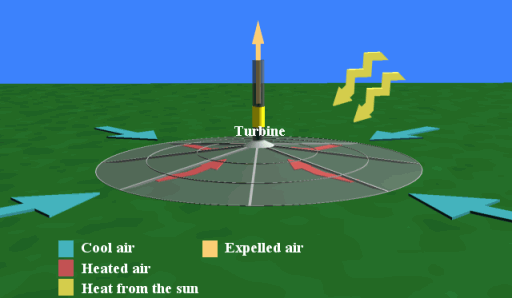Online Encyclopedia
Solar Tower
A solar tower or solar chimney is a renewable-energy power plant. Air, passing under a very large agricultural glass house (between 2 and 36 kilometres in diameter), is heated by the sun and travels upwards towards a convection tower where it rises naturally, thereby driving wind turbines, which generate electricity. The resulting electricity may be used to generate hydrogen fuel and other forms of appropriate and renewable, sustainable energy. Solar towers may be built almost entirely from recycled materials [1].
| Contents |
Benefits
The most significant byproducts include distilled water (made from ocean water or ground water), fruits and vegetables, as well medicinal and aromatic essential oils made from herbs and flowers, seaweeds and planktons, blue-green algae, all of which may be grown under the solar collector itself. Residual biomass will create additional heat during composting, as will the various distillation, food processing and manufacturing operations. Other byproducts include ethanol and methane, bio-diesel and all manner of vegetable and plant derivatives. Heat produced from the air-conditioning of factories, offices, schools, shopping malls and homes can be funneled to the towers as well to optimize refrigeration and air-conditioning operations.
Another benefit of the solar tower concept is its ability to generate surrogate solar power during cloudy periods and at night. Water vapors rising through the tower during daylight hours are condensed near the top of the solar tower and return to holding tanks situated throughout the structure. The distributed water vessels act collectively as a heat sink. The radiant heat, escaping from the water containers during overcast or cooling periods and at night, continues to drive the turbines. Near dawn, the cooled waters, driven by gravitational pull, return towards the periphery, driving hydroelectric pumps, and perform other kinetic works. Thereafter, the cooled waters may be distributed as irrigation for the tower's gardens, tree farms, reforestation projects and as domestic drinking water.
History
One of the earliest descriptions of solar chimney was written in 1931 by a German author, Hanns Günther. Most recently Sclaich, Bergerman and Partner, under the direction of German engineer Prof. Dr. Ing., Jörg Schlaich, built a working model of a solar tower in 1982 in Manzaranes , (Spain), 150 km south of Madrid, which was financed by the German Government. This power plant operated successfully for approximately 8 years. The chimney had a diameter of 10 metres and a height of 195 metres. The maximum power was about 50 kW. It was destroyed by heavy weather and thunderstorms in 1989 and was officially decommissioned. However, during the final 3 years, optimization data was collected on a second-by-second basis by Schlaich, Bergerman and Partner. The resultant data has been licensed to EnviroMission and SolarMission Technologies Inc. USA. However no patent was ever awarded and solar towers may be built at anytime, anywhere by anyone so long as local laws and official regulations are observed in the respective jurisdictions.
Intellectual property concerns
Enviromisson Ltd Australia have made claims to ownership and exclusive rights to solar tower technology, and considerable controversy surrounds these claims to geophysical territorial rights.
H. Alfred Goolsbee owns the Japanese trademark and service mark "Solar Tower®" and retains certain rights to the use of the words "Solar Tower™" in the United States as well.
Development
EnviroMission is planning to build a solar tower in Wentworth Shire , New South Wales, Australia. If built, it will become the tallest structure in the world, with a height of one kilometre. EnviroMission is also working with Sunshine Energy (Aust.) Pty Ltd. to enable development of this technology in China.
Recent negotiations to build cooperatively owned and operated solar towers are underway with organizations such as ECOSOUL, a non-profit company, who have been promoting a sustainable hydrogen economy for over 40 years collectively. Patented Reversible Fuel Cells are under consideration for use as primary components in fullscale versions of solar towers.
A meeting at NASA to further exploration of opportunities in solar tower implementation was called by H. Alfred Goolsbee, founder of the Solar Tower OpenSource Energy Project, and was held at NASA Ames Research Park in June 2003. Professor Daniel M. Kammen of the RAEL at the University of Berkeley was in attendance.
Alternate usage of the term
The term "solar tower" also refers to structures used to support equipment for studying the sun. Examples are the Mount Wilson 150 ft and 60 ft towers. The 60 ft tower is used to study helioseismology.
The term has also be used to refer to other structures used for experimental purposes, such as the (STACEE) Solar Tower Atmospheric Cherenkov Effect Experiment which is being used to study Cherenkov radiation, and the Weizmann Institute solar power tower.
See also
External links
- Solar Tower OpenSource Energy Project
- Environmission Int'l EarthNews Online
- Solar Chimney
- 150 ft Solar Tower
- Mount Wilson
- 60 ft Solar Tower
- helioseismology
- STACEE
- Weizmann Institute
- EnviroMission Ltd. of Australia Website
- Wentworth Shire, NSW - Proposed Site

